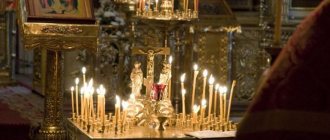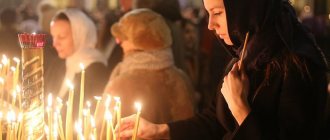| Metropolitan Vincent (Morar) |
Vincent (Morar)
(born 1953), Metropolitan of Tashkent and Uzbekistan (Central Asia), head of the Central Asian Metropolitan District, permanent member of the Holy Synod of the Russian Orthodox Church, member of the Inter-Council Presence of the Russian Orthodox Church, rector of the Tashkent Theological Seminary, holy archimandrite of the Chirchik Trinity-St. George Monastery, Chairman of the Foundation for Prizes in Memory of Metropolitan Macarius of Moscow and Kolomna In the world Morar Viktor Alexandrovich, was born on October 4, 1953 in the village of Skulany, Ungheni district of the Moldavian SSR, into a family of employees.
After graduating from high school, he served in the army from 1971 to 1973.
In 1974 he entered the Moscow Theological Seminary, in 1982 - the Moscow Theological Academy, from which he graduated in 1986 with a candidate of theology degree for the essay “The Teaching of St. Ignatius Brianchaninov on Prayer.”
In 1981, he was tonsured a monk and ordained a hierodeacon, and in January 1982, a hieromonk. Since 1982, he served as an assistant sacristan at the Trinity-Sergius Lavra.
In 1985 he was elevated to the rank of abbot, and on August 28, 1990 - to the rank of archimandrite.
On September 2, 1990, he was consecrated Bishop of Bendery, Vicar of the Chisinau Metropolis. The ordination in the Nativity Cathedral in the city of Chisinau was led by Patriarch Alexy II of Moscow and All Rus'.
On July 17, 1995, he was appointed Bishop of Abakan and Kyzyl.
| Archbishop Vincent (Morar) |
On February 19, 1999, he was elevated to the rank of archbishop.
On July 19, 1999, he was appointed Archbishop of Yekaterinburg and Verkhoturye.
On July 17, 2001, he was appointed rector of the newly opened Yekaterinburg Theological Seminary [1].
Since July 27, 2009 - member of the Inter-Council Presence of the Russian Orthodox Church.
On July 27, 2011, he was transferred to the Tashkent see, appointed head of the Central Asian Metropolitan District and appointed metropolitan. At the same time, he was entrusted with temporary management of the newly formed Bishkek and Kyrgyz (managed until December 4, 2011), and Dushanbe and Tajikistan (managed until August 1, 2012) dioceses.
On August 4, 2011, he was elevated to metropolitan dignity by Patriarch Kirill of Moscow and All Rus' in Moscow.
From October 5, 2011, he was included in the permanent members of the Holy Synod of the Russian Orthodox Church in the department, and was also relieved of his duties as rector of the Yekaterinburg Theological Seminary and appointed to the position of rector of the Tashkent Theological Seminary.
On March 9, 2021, he was confirmed as the holy archimandrite of the Chirchik Trinity-St. George Monastery [2].
He is the chairman of the Foundation for Prizes in Memory of Metropolitan Macarius of Moscow and Kolomna.
Awards
Church
- Order of the Russian Orthodox Church St. Sergius of Radonezh 2nd Art. (2000), blgv. book Daniel of Moscow 2nd Art. (2 October 2013 [3])
- Order of the Orthodox Church of Moldova b.g. voivode Stephen the Great 1st Art. (2010)
- second panagia (December 4, 2021, in accordance with the new Regulations on awards of the Russian Orthodox Church [4])
Secular
- Order of Merit of the Russian Union of Afghanistan Veterans
The son of a full Turkish woman
Among the students of the institute was Vasily Semenovich Nikitin , the future Bishop Vincent , confessor of the faith and martyr. Vasily Nikitin was born on May 28, 1892 in the village of Zamolodino, Kostroma province (according to the memoirs of G.A. Marinicheva - in Kostroma). His father, Semyon Nikitin, was a Cossack Old Believer who faithfully served his fatherland during the Russian-Turkish War of 1877–1878. From this war he brought a black-eyed Turkish beauty, baptized and married her. At that time, such marriages were not uncommon. Suffice it to remember that Honorata, the grandmother of the writer Konstantin Paustovsky , was a passionate Turkish woman, Fatima .
Having settled in Zamolodin, Nikitin took up trade. Things were going well, and soon he and his family moved to Kostroma, to their own house. But his wife died early, and Nikitin, a zealous Old Believer, had to raise his children alone in the “fear of God” and in fidelity to “ancient piety.” Prosperity made it possible to give the children a good education and in 1906 the merchant sent his son Vasily to study in Moscow, at the Old Believer City School.
Having completed his studies in 1910, Vasily returned to Kostroma. He chose the pedagogical path and began giving Russian language lessons. Two years later, Vasily moved to the village of Ocher, Perm province. Many Old Believers worked at the local Ochersky plant, through whose efforts a temple was built in 1912, and a school was opened with it, where Nikitin worked for a year as a primary school teacher.
In 1913 (according to other sources in 1912), Vasily left for Moscow and entered the Old Believer Theological and Teachers' Institute, but he was not destined to complete his studies - the First World War began.
In September 1916, Vasily Nikitin was drafted into the army. He went to the Austrian front with the rank of private, but thanks to his good education he was assigned to the headquarters as a clerk. But then 1917 came...
The October Revolution and the events that followed it revealed the true meaning of the revolution and showed the true face of the revolutionaries. The “Red Terror” began, sweeping Russia in a bloody wave for many years. The fight against religion was declared by the Bolsheviks to be “of utmost importance.” The persecution of the Old Believers began again, more merciless and cruel than ever. Over the next twenty years, “commissars in dusty helmets” will destroy the stronghold of the Old Believer Church - the merchants, Cossacks and peasantry. Thousands of Old Believer clergy will be repressed, hundreds of churches will be destroyed, and all monasteries will be closed.
The war ended for Vasily Nikitin in January 1918, and in February he returned to Kostroma. Here he married Marya Ivanovna Mokhova , the daughter of a carpenter from the Yaroslavl province, the leader of the choir of the Kostroma Old Believer Church. Although Marya was three years older than her husband, they lived in perfect harmony.
Returning from the front, Vasily got a job as a librarian and continued his education - he completed a one-year teacher's course and received the title of “teacher of the first degree.” In June 1919, the young couple had a daughter, Kaleria, and in August, Vasily Semenovich was again drafted into the army, this time to the Red Army.
Nikitin ended up in the Kostroma cavalry reserve, where he served until April 1921 as a “cult worker” - he taught illiterate Red Army soldiers to write and read. He perceived the possibility of demobilization as great happiness. The day after his discharge from the army, Vasily was ordained a priest for the parish of the Kostroma village of Kunikovo .
Used materials
- Biography on the official website of the Moscow Patriarchate:
[1] Journal of the meeting of the Holy Synod of July 17, 2001
,
[2] “Journal No. 20”, JOURNALS of the meeting of the Holy Synod of March 9, 2021
, official website of the Russian Orthodox Church, March 9, 2017,
[3] The first meeting of the winter session of the Holy Synod of the Russian Orthodox Church has ended in Moscow
, October 2, 2013, official website of the Russian Church:
[4] In accordance with paragraph 2.2.4 of the Regulations on Awards of the Russian Orthodox Church, which states: The right to wear the second panagia belongs, within the limits of their canonical appanages, to the heads of the Japanese Autonomous Church, the Self-Governing Orthodox Church in Moldova, the Latvian Orthodox Church, the Estonian Orthodox Church, the Belarusian Exarchate , Metropolitan District in the Republic of Kazakhstan, Central Asian Metropolitan District; “His Beatitude Theodore II, Patriarch of Alexandria and All Africa, led a solemn service in the Cathedral of Christ the Savior on the day of the 100th anniversary of the enthronement of St. Tikhon, Patriarch of Moscow,” official website of the Moscow Patriarchate, December 4, 2021,
The Devil survives Metropolitan Vincent of Tashkent
Metropolitan Vincent faced a serious challenge in Tashkent Photo - Wikipedia
Former Archbishop of Yekaterinburg and Verkhoturye Vikenty, who left to serve in Uzbekistan five years ago, found himself at the center of a scandal. Both the Moscow Patriarchate and the secular authorities of both states are aware. The flock is split: one part of it complains about the “Varangian”, seeing grave sins behind him, the other signs petitions in his support. What is happening in Tashkent, who is accusing the Metropolitan of what - details in the URA.Ru material.
Parishioners of the Holy Dormition Cathedral complain about Metropolitan Vincent of Central Asia. The clergyman, well known to the Urals, as URA.Ru has already written, is accused of many sins, of which rude treatment of women is not the most serious. We ask the Patriarch to recall the Metropolitan.
The priest was accused of money-grubbing, baptism for money, violating the canons of Orthodoxy, and almost pagan judgments.
Related news
The ex-head of the Yekaterinburg diocese is accused of paganism and greed
They recalled Vincent’s grand celebration of his 60th birthday, without specifying, however, that this took place back in 2013 - two years after the clergyman’s arrival in Tashkent. Nevertheless, the list, although large, was anonymous - the author (or authors) is not yet known to the general public.
“URA.Ru” called Tashkent and received a comment from Father Mikhail (Stolyarov), responsible for media relations. Despite his position, the interlocutor did not open up, calling the authors of the anonymous letter “cowardly people afraid to show their faces.” “We have suspicions about who did this. I won’t name him, time will tell who it is,” the interlocutor replied.
Stolyarov suggested that these could be either parishioners or a once influential official of the local diocese, perhaps a former one.
Faithful parishioners, in turn, mobilized to support Metropolitan Vincent, collecting 500 signatures on a petition in his support. The paper names the main culprit in the current situation - the devil. A message with words of support for the good shepherd was also sent to the Moscow Patriarchate.
In Yekaterinburg, where the archbishop is well remembered, they are surprised by what is happening in Central Asia. Father Evgeniy (Popechenko), who knew Metropolitan Vikenty, did not dare to guess what conflicts the former “boss” could have caused.
Holy Dormition Church in Tashkent
Photo - Wikipedia
Another interlocutor of URA.Ru, who wished to remain anonymous, admitted that there could be a conflict, but expressed hope for its peaceful conclusion. In general, all interlocutors admit that over the past years they have lost contact with the former ruler.
Some details of the scandal were revealed by the Fergana.ru website, publishing an interview with one of the authors of the complaint to Patriarch Kirill. In an interview with the editor-in-chief of the online publication Daniil Kislov , an unnamed man confirmed that the appeal to the patriarchy is not the first and that there are other authors with a similar point of view on the policies of Metropolitan Vincent .
In a conversation with his interlocutor, Kislov established that the authors, including the clergy, had not previously even hidden their names. “Our letter to the patriarch is signed, our addresses and telephone numbers are indicated there. We sent it through the Uzbek Embassy in Moscow.
Letters that other people had previously sent directly to the Patriarchate returned to him, to Vincent. Then he comes out, shakes these letters and says that “nothing will happen to me,” and so on.
Therefore, we sent a letter through the embassy, as well as to all the highest authorities of our republic,” says the parishioner. In his opinion, the complaints were either intercepted by Vincent’s friends in the Patriarchate or were of no interest to the clergy.
An open letter to the media, Fergana.ru’s interlocutor is sure, has a greater chance of being seen and read.
Confirming everything that was previously published on URA.Ru, the interlocutor clarified that for the Metropolitan, the flock is considered as “walking wallets” and a source of income, the churches of the entire diocese have turned into “shopping centers”, and the Holy Dormition Church of Vincent is “tormented” , carrying out pointless (and illegal) roof repairs.
“URA.Ru” will monitor the development of the situation around the person of Metropolitan Vincent.
Vladika Vincent
In September 1928, the Consecrated Council of the Old Believer Church took place, the last one before a long break. At this Council, Father Vasily was asked to accept the rank of bishop, and with it the burden of responsibility of hierarchal service in the terrible days of new persecution of the faith. The priest refused, but the council members, with great difficulty, persuaded him:
Yes, times are difficult, but even more so we must not think about ourselves: we need to support the believers. Christ did not promise his followers earthly prosperity - on the contrary, he called for self-denial. And this primarily applies to bishops. It is not for nothing that in the rite of the holy vestment it is sung: if anyone wants to follow Me, let him deny himself, says the Lord, and take up his cross and follow Me, always and now and ever and forever and ever, Amen.
Savatius , who arrived from the northern region, from the land of Arkhangelsk . He added his voice to the voice of the Council, blessing his son to take the way of the cross. It was decided that he would lead the Caucasian diocese instead of the deceased Bishop Theodosius (Monokov). Humbly agreeing, Father Vasily begged with tears:
Just don't leave my children!
Right during the Council, on September 16, the priest was tonsured a monk and named Vincent , and a week later (06.10 (23.09 art.)) he was consecrated bishop for the Caucasian diocese. Together with his family, the newly installed bishop went to Essentuki, where he settled in the church gatehouse at the Old Believer church.
It was a terrible time... The Soviet government began a ruthless fight against the “religious dope.” The episcopate of the Old Believer Church was almost completely repressed. Its temples were closed. The threat of ruin loomed over the Rogozhsky cemetery. In 1929, services in the majestic Nativity Cathedral were stopped. The temple was disfigured and converted into a canteen for workers. Now near him one could see not pious pilgrims, but foul-mouthed drunken proletarians. It was assumed that the oldest Intercession Cathedral would be closed and rebuilt into a theater, but it miraculously survived. In 1930, the bells were removed from the Resurrection Church-bell tower. Three years later, this temple was also closed.
The Soviet government imposed huge taxes on the “parasitoid” clergy. Many priests could not pay them, and therefore renounced their priesthood. A striking illustration of the disasters of that time is a letter from Bishop Vincent to the Old Believers of the Voznesensk community of the Tsaritsyn farmstead:
“Your priest, Father Joachim, wrote to me more than once about his difficult financial situation and finally came to me himself. From a conversation with him and from his letters, I was convinced that Father Joachim was subject to an unbearable tax and that you, brothers, provide him with almost no help in paying the tax. I consider it my pastoral duty to remind you that financial assistance to a priest is your indispensable responsibility... I bless you to apply all your diligence to collect the amount to pay the tax for Father Joachim in the shortest possible time. You also need to take care of helping the priest in the future. It is necessary to help him not only with money and food, but also with chores and petitions to the civil authorities. Otherwise, I will be forced to transfer the priest to another parish.”
Father Vasily
The following year, the father of the young priest was also called to church service. The venerable widower Semyon Nikitin was tonsured a monk, named Savatiy , and on June 5, 1922, ordained a bishop with the title “Bishop of Yaroslavl, Vologda and Arkhangelsk.” At the end of the 1920s, Bishop Savatiy was arrested, but was soon released. According to some sources, he remained in the North, where he died “of old age” in 1932. According to others, the elderly bishop returned to die in Kostroma.
Soon after his ordination, Father Vasily met the famous Bishop Gerontius (Lakomkin, 1872–1951), the Old Believer Bishop of Petrograd and Tver, a native of the Kostroma province. The bishop often came to his homeland and helped his fellow countrymen build churches and set up schools. In Kunikovo, through his efforts, a stone temple was built.
The bishop liked the village priest, who was distinguished by his good education and extraordinary intelligence. Together they organized several parochial schools. There were not enough teachers, so in 1924 it was decided, secretly from the authorities, to open courses for the training of Old Believer teachers. It was assumed that Father Vasily would teach the Russian language, and Bishop Gerontius would teach the church charter. But the authorities became aware of the organization of the courses. The priest was arrested and kept under arrest for about a month, and then released on his own recognizance.
It was dangerous to remain in the Kostroma province. Therefore, in February 1925, on the recommendation of Bishop Gerontius, Father Vasily was transferred to Moscow, to the churches of the Rogozhsky cemetery. But life was preparing a new test for the young priest, the most painful and difficult one. In January 1926, Marya Ivanovna died of sarcoma. Father Vasily’s grief was immeasurable; he lost a lot of weight, became haggard, and had a darkened face. I often went to my wife’s grave and cried. Subsequently, Soviet newspapers would accuse Bishop Vincent of not loving his wife. Allegedly, wanting to quickly achieve episcopal rank, he deliberately brought his wife to death from consumption through “systematic beatings.”
Refuting this lie, Galina Marinicheva (1923–1993), a long-time parishioner of the Rogozhsky cemetery, wrote in her memoirs:
All the residents of Rogozh, even when Vincent served as priest of the Rogozhsky cemetery, knew well the bishop himself, the late mother - a woman of exceptional, subtle beauty, they knew how deeply he loved her and how caringly he treated her. We saw with our own eyes the immense and inconsolable grief of a widower with small children... Yes, everyone knew, but no one dared to write a refutation of the obvious slander.
Father Vasily's daughter Kaleria and son Lev remained in the arms of father Vasily. Daria Semyonovna began to help him with the children and with housework .









